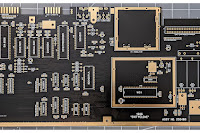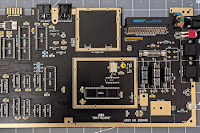
Way back in the mists of time... Ok, it was 2005 but it feels like a lifetime ago, I got the urge to build my own camera. This idea came from a science lesson in school so far back I daren't think about the date but the lesson had been a simply one: get a shoe box; cut a square/rectangular hole in the base; cover the hole with parchment paper; affix the lid tightly; push a pin into the middle of the lid; cover your head and the rear of the box with a large towel (or similar) with the pinhole exposed to the outside world and if you've got yourself pretty light-tight then you should see an inverted and reversed view of the world projected onto the parchment paper. When this silly little experiment worked I was pretty blown away. Here was photography all simplified down to something as simple as a shoe box with a hole in it.
Ever since that science class I'd wanted to take this to the next stage - using those same simple principles to actually take a photo. I have absolutely no recollection of how I found out this could be done with photo paper (not the stuff you put in a printer at home to print your holiday snaps but real, photo-sensitive paper) but I knew it could be done and with the necessary supplies purchased, the quest slowly became a reality.
(1) 6 Pieces of wood (cut from old shelving)
(2) Strong Glue
(3) 4 Massive Steel bolts
(4) 4 Wing Nuts to fit massive bolts
(5) 8 Washers to fit massive bolts
(6) 2 pieces of leather
(7) 1 smaller bolt
(8) 1 smaller wing nut to fit smaller bolt
(9) 3 thin pieces of wood
(10) 1 thin piece of aluminium (cut from soda can) for pinhole.
(11) Flat Black paint.
(12) Several small screws.
You will also need:
(13) Photosensitive Paper
(14) Developing Solution
(15) Stopper Solution
(16) Fixer Solution
(17) 3 x Plastic Trays for above solutions
(18) Measuring Jug
(19) Cold Water (1 bucket of)
(20) Stopwatch
(21) A very dark room
(22) A red light.
(23) A thermometer
First things first, I needed to build the camera. Now there are ways to do this which are very clever measured and calculated. Or, you can do what I did and hack at wood until it approximately fit together then use absolute shit-tons of glue and wood-filler to seal the gaps. You see, I have none of the skills required to make something which looked like a camera, So I just bodged together a sturdy light-tight box that would easily come apart so that I could remove and load the paper. The design I came up with was broadly functional, met my needs, but, frankly, damned fugly:
I knew that there were certain features I wanted to incorporate: an easy way to change the pinhole lens if necessary, and the ability to adjust the focal length if required and a mechanism to cover the pinhole when not in use so I came up with the design you see above. First I built a four sided rectangle (3.5" x 4.5" approx) and drilled a 1" hole in the face. Then I fashioned two wooden "plates" to cover this hole. The pinhole (0.4mm diameter) is sandwiched between these two plates. The plates are simply screwed to the body and it's a two minute job to unscrew and get access to the pinhole. The "shutter" is cut and shaped from a thin piece of wood and held in place with a small bolt and wingnut inside the camera. To expose the picture one simply pushes the shutter up to expose the pinhole and down to cover it.
Next I needed a way to hold the paper in the camera, so I came up with the idea of a simple frame - a backplate with two brass paper fasteners stuck through, and a facing frame, held in place by the paper fasteners. The frame is 2.75" x 2.75" approx. The paper is simply sandwiched between the two. To insert/remove the paper I simply bend the brass fasteners back/forward and insert/remove.
Inside the camera, I've stuck two small pegs which hold the frame inside the camera against the back wall. The frame just slides in and out like a drawer. To adjust the focal length I would need to add more pegs to allow the frame to sit closer to the pinhole.
Finally, I needed a way to: A) Seal the box B) Make it light tight and C) give me easy access. As I said earlier, I'm really bad at woodwork and I knew I couldn't make a hinge so I came up with the idea of a clamp type mechanism. By placing the box between two chunks of pine, and using enormous bolts (4.5" long) with thumb screws it could be clamped shut. I was pretty confident this wouldn't be light tight so I use two pieces of leather between the box and the top and bottom clamps to seal it. The end result is completely light tight.
It should also be stated that at the time of construction I had absolutely no idea about focal length and optimum aperture. I was completely winging it. Later calculations established that a 0.4mm pinhole and 95mm focal length (distance from the pinhole to the photo paper) meant the camera had an f/stop of about f/240 - The f/stop number is determined by the focal length divided by the diameter of the aperture which in this case is 95 / 0.4 = 237.5. As for the optimum aperture (pinhole size) - I don't know calculus so I couldn't figure this out by myself but luckily there's a Pinhole Camera Design Calculator to do the hard graft for you. However that's all pretty academic - it will work with a random sized hole (that's not too big).
On the 5th August 2005 I set my newly built camera in the window of my lounge and made a 5 minute exposure. I rushed off to my makeshift darkroom (which was just a cupboard) and went through the process of exposing the image. I will never forget my excitement when a picture slowly started to form on the paper as it sat in the developing solution and I was literally shaking when I stopped and fixed it. I could not believe that on my first ever attempt at any of this, I had actually produced a legible image. Here is a scanned and inverted copy of that first picture:
 |
| The first image I ever made with my pinhole camera |
That picture might not look like much to you, but this was my "View from the Window at Le Gras". It was the culmination of months of work and planning and literally years of wondering if I could do it and for that reason I'll always love that silly little picture.
With this first triumph under my belt I pretty much spent all of my free time during the rest of 2005 experimenting with my camera obscura and truth be known I had a lot more failures than success. All said I took about 50 exposures. Now bearing in mind that this camera could only take one exposure at a time, getting 50 exposures was quite the feat. I had to travel to my planned destination, expose the image, return home, develop the image and after all of that can you imagine how heartbreaking it was to see most of them turn completely black in the developing solution due to over-exposing? There's probably an app for that these days but in 2005 and not able to afford a light meter I needed the "Sunny 16 rule" which for this camera amounted to:
- Bright sunlight, very distinct shadows: 23 seconds.
- Slight overcast, soft edges to shadows: increase by one stop (factor of 2) 46 seconds.
- Overcast, barely visible shadows: increase another stop (factor of 4) 92 seconds.
- Heavy overcast, no shadows: increase another stop (factor of 8) 184 seconds.
 |
| Lighthouse. 23 Second Exposure. |
 |
| Graveyard. 12 Minute Exposure. |
 |
| Self Portrait. 10 Minute Exposure. |
Towards the end of 2005 I stopped using this camera. My developing chemicals had become exhausted and the single exposure limit was too much hard work and so I packed it all up in a sturdy box, and there it remains to this day, just waiting for me to dig it out and have another play. One day I might do just that but in the meantime I still take a great deal of pride in what I was able to do with some bits of old shelf and a soda can.
Since 2005 I've learned more about this technique so I'd do some things differently. For example, it never occurred to me that the paper developing solution I used would affect the final product - I assumed that because they all work the same way the output would be similar regardless. Wrong. The pictures here are too "contrasty" (not enough detail in the either the shadows or the highlights) and that's very likely because of the the particular brand and type of paper developing solution I used (which was designed for developing positive paper prints, not paper negatives). Doing this again I would use a film developer which is weaker and should give less contrast and more tone to the final paper negative. I would also invest in a film changing bag to allow me to change out the paper in the field, which, frankly, was a damned stupid omission in the first place.
Speaking of stupid, around the same time I tried to make my own photosensitive paper with silver nitrate... that didn't go to plan at all. It took a week for my skin to get back to normal after that fiasco. But that, as they say, is a story for another time.
Since 2005 I've learned more about this technique so I'd do some things differently. For example, it never occurred to me that the paper developing solution I used would affect the final product - I assumed that because they all work the same way the output would be similar regardless. Wrong. The pictures here are too "contrasty" (not enough detail in the either the shadows or the highlights) and that's very likely because of the the particular brand and type of paper developing solution I used (which was designed for developing positive paper prints, not paper negatives). Doing this again I would use a film developer which is weaker and should give less contrast and more tone to the final paper negative. I would also invest in a film changing bag to allow me to change out the paper in the field, which, frankly, was a damned stupid omission in the first place.
Speaking of stupid, around the same time I tried to make my own photosensitive paper with silver nitrate... that didn't go to plan at all. It took a week for my skin to get back to normal after that fiasco. But that, as they say, is a story for another time.




